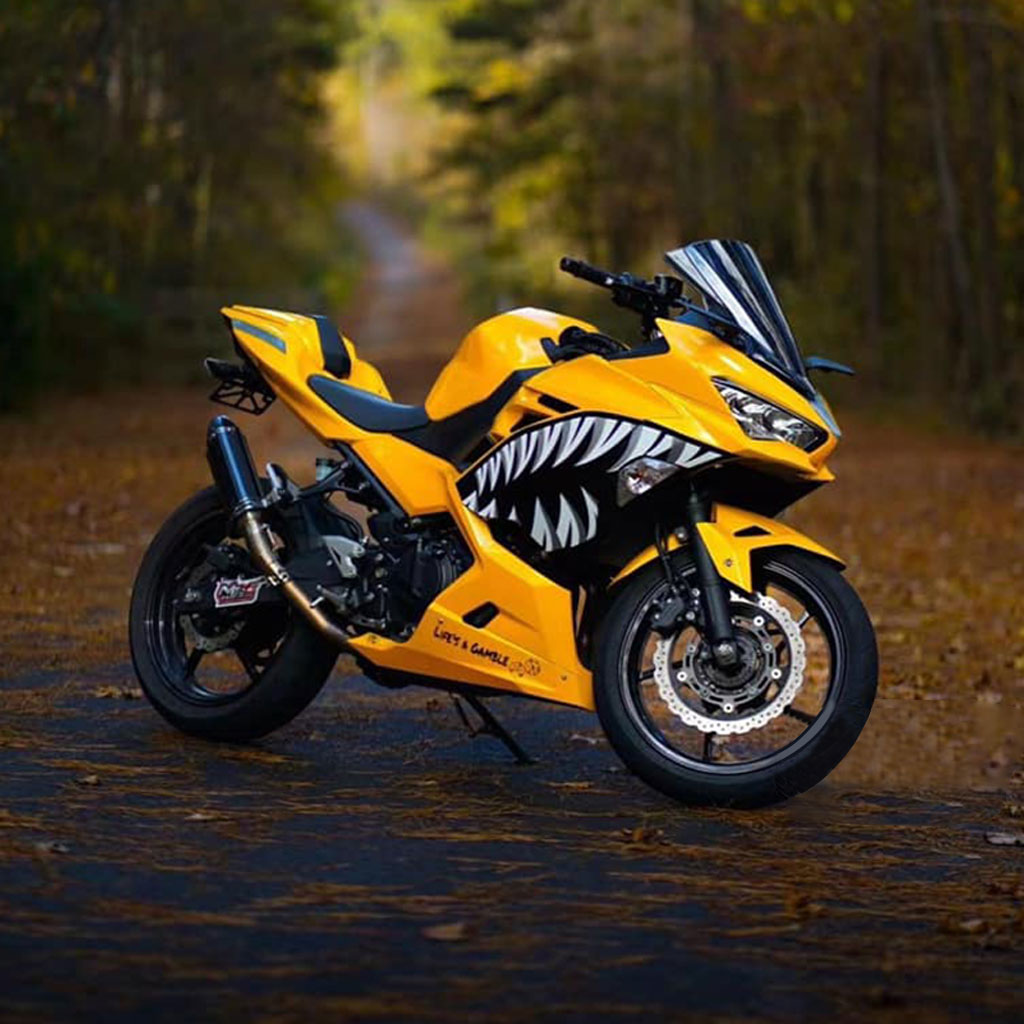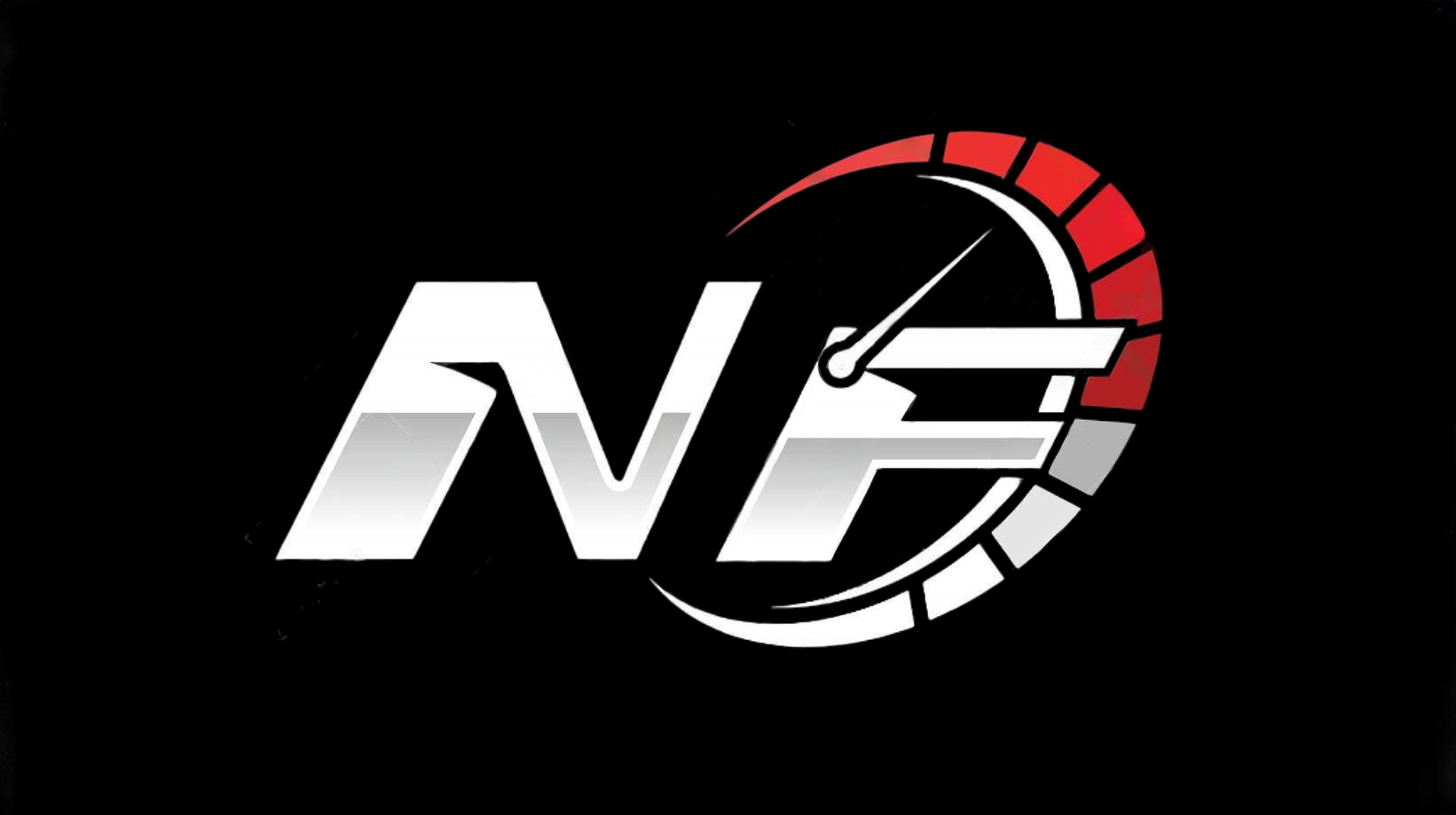Complete Guide to Kawasaki Ninja 650R 2016 Specs and Performance
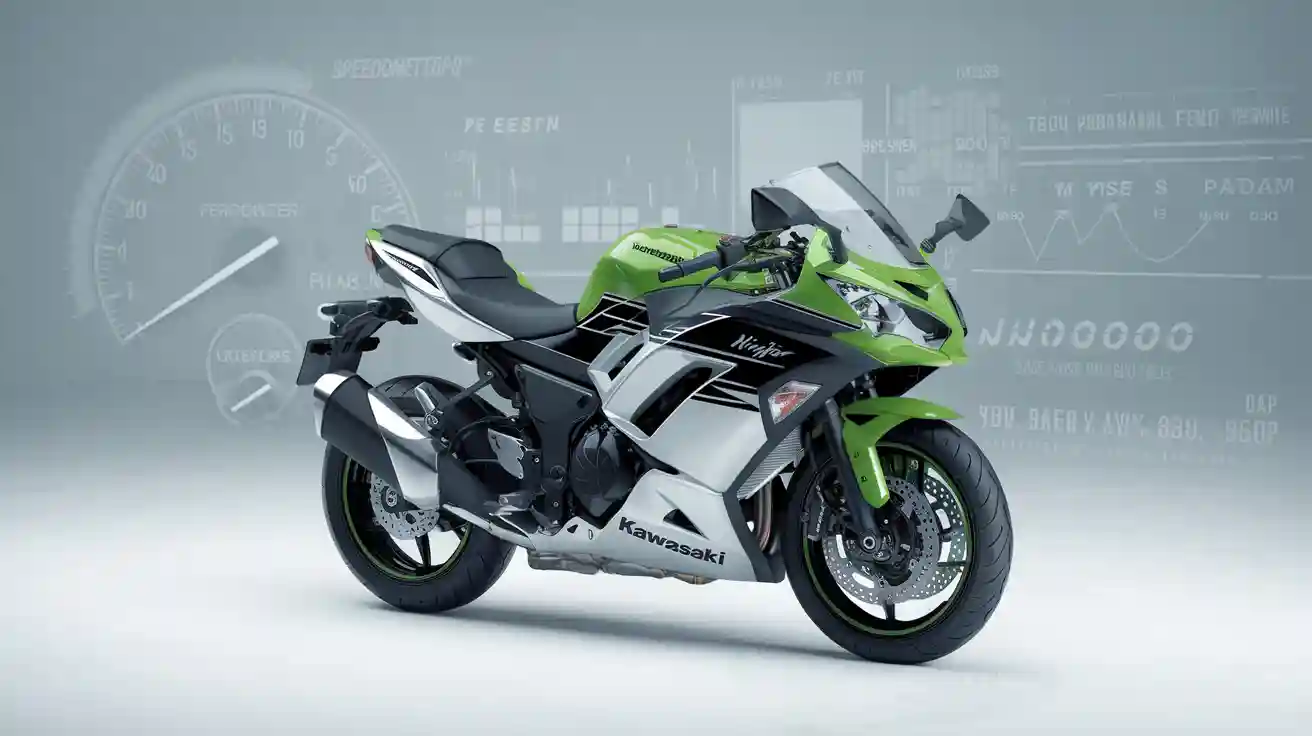
You notice the kawasaki ninja 650r 2016 motorcycle stands out in the world of mid-range sport motorcycles. The ninja 650 features a 649cc parallel-twin engine with Digital Fuel Injection, which gives you smooth and reliable power. The motorcycle’s double-pipe perimeter frame helps you feel confident, while the low seat height makes it easy to control. Riders often choose the kawasaki ninja 650r 2016 because it combines sporty ninja styling with practical features that suit daily use.
- Key features you find on the kawasaki ninja 650r 2016 motorcycle:
- 41mm front fork and an offset rear shock for comfort and control
- Adjustable rear suspension preload
- Positive neutral finder and wide handlebar for easy handling
- Optional ABS brakes for added safety
- Distinctive ninja bodywork and compact 650 design
The motorcycle offers a comfortable seat and smart footpeg placement, making every ride enjoyable whether you use your ninja 650 for commuting or fun.
Kawasaki Ninja 650R 2016 Detailed Specifications
Engine and Power
You get a 649cc parallel-twin engine when you ride the kawasaki ninja 650r 2016. This engine uses liquid cooling and digital fuel injection. It gives you strong mid-range power, which helps you accelerate quickly and ride smoothly in city traffic or on highways. The engine produces about 67 bhp and 48.5 lb-ft of torque. These numbers put the ninja 650 in the middleweight sport motorcycle class.
Here is a quick look at the main engine specifications:
| Specification | Value |
|---|---|
| Engine Displacement | 649 cc |
| Horsepower | 67 bhp |
| Torque | 48.5 lb-ft |
You notice that the engine in the ninja 650 balances performance and everyday use. It is less powerful than the kawasaki ZX-6R, which has an inline-four engine and much higher horsepower. However, it gives you more power than the smaller ninja 400. This makes the ninja 650 a great choice if you want a bike that is not too aggressive but still fun to ride. The engine uses a double overhead camshaft (DOHC) with 8 valves, which helps it breathe better and deliver smooth power. You will feel the torque kick in at lower rpm, making the bike easy to handle in many situations.
Transmission and Drivetrain
You shift through a 6-speed manual transmission on the ninja 650. The gearbox feels smooth and helps you find the right gear for any speed. The final drive uses a chain, which is common for sport motorcycles. This setup gives you direct power delivery to the rear wheel.
Tip: The clutch system in the kawasaki ninja 650r 2016 uses special friction and steel plates. These plates resist heat and wear, so you get better grip and longer clutch life. The clutch engages quickly, which helps you launch the bike faster and shift gears with confidence. The clutch plate cores are CNC machined from strong aluminum, making them durable even if you ride hard or in tough conditions.
You will notice that the clutch feels responsive, especially in stop-and-go traffic or during spirited riding. The positive neutral finder makes it easy to find neutral when you stop at lights.
Chassis and Suspension
The chassis of the ninja 650 uses a steel trellis frame. This frame is light and strong, which helps you control the bike easily. The swingarm is also made from steel and connects to a rear shock with a progressive linkage. The front suspension uses a 41 mm non-adjustable fork. The rear shock lets you adjust preload, so you can set it up for your weight or riding style.
You will find that the suspension gives you a good mix of comfort and sporty handling. The lighter frame and wheels reduce the load on the suspension, so the bike feels stable and easy to steer. The rear shock smooths out bumps, but the front fork can feel soft on rough roads or in bumpy corners. Many riders upgrade the suspension for better handling, especially if they ride fast or carry a passenger.
Note: If you adjust the rear shock or upgrade both front and rear suspension, you can improve cornering stability and reduce fatigue on long rides. The ninja 650's suspension works well for most riders, but you can make it even better with a few changes.
The chassis and suspension work together to give you confidence, whether you ride in the city or on twisty roads. The bike feels light and easy to maneuver, making it a good choice for new and experienced riders.
Brakes and Tires
You rely on strong brakes and quality tires for safety and control on the kawasaki ninja 650. The 2016 model gives you a solid braking system that helps you stop quickly and confidently. The front brakes use dual 300 mm discs with two-piston calipers. The rear brake uses a single 220 mm disc. This setup gives you balanced stopping power for both city and highway riding.
| Brake Position | Disc Size | Caliper Type |
|---|---|---|
| Front | 300 mm | Dual discs, two-piston calipers |
| Rear | 220 mm | Single disc |
You feel the front brakes work well for most situations, but some riders notice the pressure point is not as sharp as on higher-end sport bikes. The optional ABS system adds another layer of safety, especially in wet or slippery conditions.
Tires play a big role in how your ninja 650 handles. The standard tire sizes are 120/70-17 for the front and 160/60-17 for the rear. These sizes give you a good mix of grip and comfort. You can choose from many recommended tire brands and models that fit the kawasaki ninja 650 perfectly.
| Tire Aspect | Details |
|---|---|
| Front Tire Size | 120/70-17 |
| Rear Tire Size | 160/60-17 |
| Recommended Tire Brands and Models | Notes |
|---|---|
| Michelin Front Scorcher 21 | Exact fit |
| Metzeler Racetec RR | Exact fit |
| Shinko 705 Series Dual Sport | Exact fit |
| Dunlop Sportmax Q5A | Exact fit |
| Bridgestone Battlax BT-020 | Exact fit |
| Pirelli MT 60 RS | Exact fit |
| Pirelli Scorpion Trail II | Exact fit |
| Continental TKC70 | Exact fit |
| Pirelli Scorpion Rally STR | Exact fit |
| Dunlop Sportmax GPR-300 | Exact fit |
| Continental Trail Attack 3 | Exact fit |
| Bridgestone Battlax Adventurecross Scrambler AX41S | Exact fit |
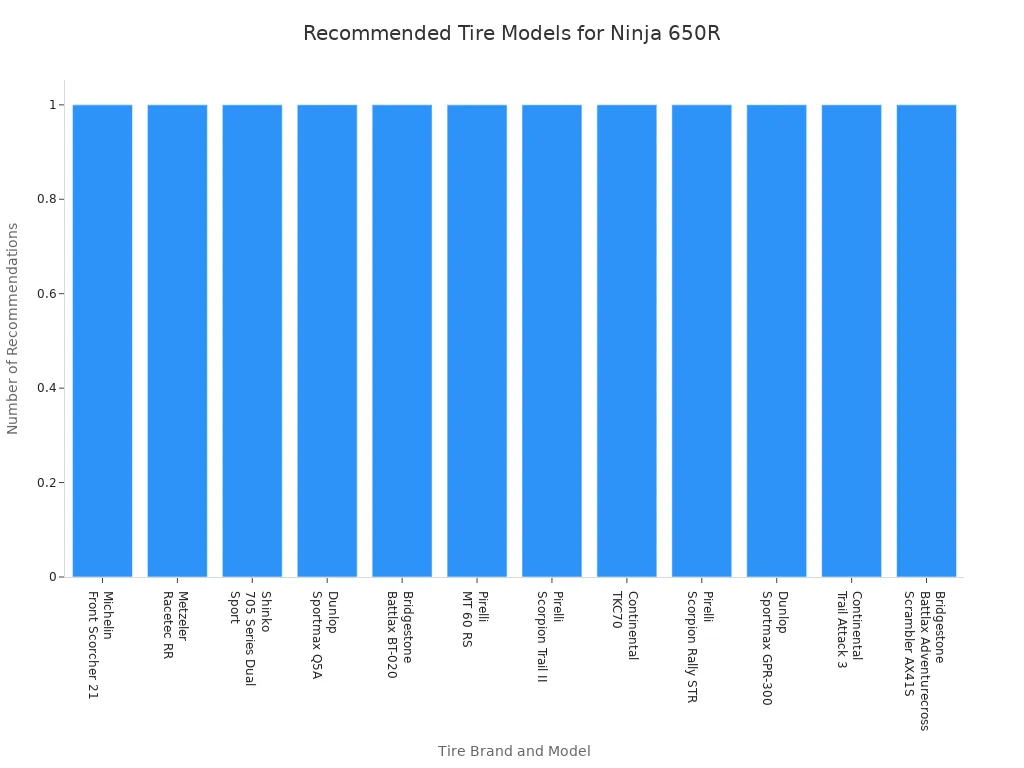
Tip: You should check your tire pressure and tread often. Good tires and brakes help you stay safe and enjoy the full performance of your ninja 650.
Dimensions and Weight
When you look at the specifications of the kawasaki ninja 650, you see a motorcycle designed for both comfort and control. The wheelbase measures 55.5 inches, which helps you feel stable at high speeds and nimble in tight turns. The rake and trail are set at 25 degrees and 4.3 inches, giving you predictable steering.
| Specification | Value |
|---|---|
| Wheelbase | 55.5 inches |
| Rake/Trail | 25° / 4.3 in |
| Seat Height | 31.7 inches |
| Wet (Curb) Weight | 467 lbs |
You sit at a seat height of 31.7 inches. This height lets most riders reach the ground easily, which boosts your confidence when stopping or parking. The wet weight of 467 pounds includes all fluids and a full tank of gas. You notice the ninja 650 feels lighter than it looks, thanks to its smart frame design and low center of gravity.
Note: The compact size and moderate weight make the kawasaki ninja 650 a great choice for new riders and those who want a bike that is easy to handle in traffic or on winding roads.
Features and Technology
You get a mix of modern features and proven technology on the kawasaki ninja 650R 2016. The bike uses digital fuel injection with dual 38mm throttle bodies. This system helps you start the engine easily and keeps fuel use efficient. The optional ABS system gives you extra confidence when braking hard or riding in bad weather.
| Feature | Description |
|---|---|
| Digital Fuel Injection | DFI system with dual 38mm throttle bodies |
| ABS | Optional electronic Anti-lock Braking System |
| Traction Control | Not included |
| Ride Modes | Not included |
| Advanced Rider Aids | Not included |
You do not find advanced electronics like traction control or ride modes on this model. The kawasaki ninja 650 focuses on giving you a direct and simple riding experience. The display is clear and easy to read, showing you speed, rpm, fuel level, and trip information.
Callout: The 2016 ninja 650 stands out for its balance of comfort, sporty feel, and beginner-friendly features. You get a reliable motorcycle with the right mix of technology for daily use and weekend rides.
2016 Kawasaki Ninja 650 ABS Performance Analysis
Acceleration and Top Speed
When you ride the 2016 kawasaki ninja 650 abs, you feel the strong acceleration right away. The bike’s 649cc engine delivers a quick burst of power, making it easy to merge onto highways or overtake slower vehicles. You can reach 0-60 mph in just 3.53 seconds. This speed puts the ninja 650 abs ahead of many other bikes in its class.
| Metric | Value |
|---|---|
| 0-60 mph | 3.53 seconds |
| Top Speed | Approximately 130 mph |
You notice that the top speed of the 2016 kawasaki ninja 650 abs is around 130 mph under ideal conditions. Most riders will see speeds between 120 and 125 mph, depending on wind and riding position. When you compare this to the ninja 400, which tops out at 116.7 mph, you see a clear advantage in real-world performance.
| Motorcycle | Top Speed |
|---|---|
| Ninja 400 | 116.7 mph |
| Ninja 650 | 130 mph |
The larger engine and higher torque give you a stronger pull at all speeds. This makes the bike a great choice if you want both quick acceleration and a high top speed for sport riding.
Tip: If you want to get the best acceleration, keep the engine in the mid to high rpm range. The torque curve helps you feel strong power even at lower speeds.
Handling and Cornering
You will enjoy the handling of the 2016 kawasaki ninja 650 abs, especially on twisty roads. The bike feels light and easy to steer. The compact chassis fits many rider sizes and styles, so you feel comfortable and in control. The nearly upright riding position helps you shift your weight and react quickly in corners.
- The steel trellis frame keeps the bike stable.
- The 41mm front forks and single offset rear shock provide balanced suspension.
- The underside exhaust helps centralize weight for better balance.
- Lightweight construction supports neutral handling.
Expert reviews praise the ninja 650 abs for its direct steering. You can flick the bike from side to side with little effort. The suspension feels firm enough for most street conditions, giving you confidence when you lean into a turn. The triangulated steel swingarm and lay-down shock add to the bike’s stability.
You may notice some limits if you push hard on rough pavement. The suspension and tires can feel soft at higher cornering speeds. For most riders, the bike offers a fun and predictable ride. You can carve through canyons or enjoy a relaxed cruise with equal ease.
Note: The 2016 kawasaki ninja 650 abs stands out for its versatility. You get a bike that handles daily commutes and spirited rides with the same level of comfort and control.
Throttle Response and Braking
You feel a smooth and predictable throttle response every time you twist the grip. The digital fuel injection system delivers power evenly, so you can control your speed with confidence. The clutch and shifting action are light, making it easy to ride in traffic or on open roads.
When you need to stop, the braking system gives you solid performance. The front uses dual 300mm discs with two-piston calipers, while the rear has a single 220mm disc. The ABS system helps prevent wheel lock-up, especially in wet or slippery conditions. You will notice that the brakes work well for moderate speeds and daily riding.
Some riders find the brakes less powerful during aggressive sport riding. If you want sharper stopping power, you can upgrade the brake pads or install steel braided lines. The addition of ABS in the 2016 model improves safety and gives you more confidence, especially if you ride in changing weather.
Callout: Always check your brake pads and fluid levels. Good maintenance keeps your braking performance strong and reliable.
Comfort and Ergonomics
You will notice that the 2016 kawasaki ninja 650 abs puts your comfort first. The seat sits at about 31.7 inches, which helps many riders with shorter inseams reach the ground easily. The seat is also narrow at the front, so you can flat-foot the bike at stops. This design gives you more confidence, especially if you are new to riding.
The riding position feels upright and relaxed. The handlebars sit farther forward and lower than before, but you do not lean too much. Your wrists and back stay comfortable, even on longer trips. The footpegs move forward and lower, so your legs bend less. This setup helps you avoid cramps and makes it easier to shift your weight during a ride.
You will find these ergonomic features on the 2016 kawasaki ninja 650 abs:
- Sporty but not extreme riding posture
- Lowered and narrowed seat for better reach
- Clip-on handlebars placed forward and lower for a balanced feel
- Footpegs moved forward and lower for relaxed leg position
- Slim fuel tank for a slender feel between your knees
- Upright seating for comfort and control
The seat and tank design make the bike feel slim. You can grip the tank with your knees, which helps you stay steady during turns. The clutch engages smoothly, and the gearbox feels well-spaced. This makes city riding and highway cruising easy and enjoyable.
If you plan to ride long distances, you will appreciate the upright posture. You do not put much weight on your wrists, so you feel less tired after hours on the road. The seat supports your lower back, and the riding position lets you look around easily. Some vibration comes through the seat, but most riders do not find it bothersome. If you need more legroom, you can choose an accessory seat that raises the height by an inch.
Tip: For the best ride comfort, adjust the seat and handlebars to fit your body. You can also add an extended reach seat or a taller windscreen for extra support on long rides.
Fuel Efficiency
You want a motorcycle that saves fuel and keeps your costs low. The 2016 kawasaki ninja 650 abs gives you good fuel efficiency for a sport bike. Riders report an average of about 43.5 miles per gallon in real-world use. This number comes from many riders who tracked their fuel-ups over thousands of miles.
The fuel tank holds 4.0 gallons. With this size and the average fuel economy, you can expect to travel over 170 miles before you need to fill up. This range makes the bike a smart choice for daily commuting or weekend trips.
| Specification | Value |
|---|---|
| Average MPG | 43.5 |
| Fuel Tank Capacity | 4.0 gallons |
| Estimated Range | 170+ miles |
You will notice that the engine runs smoothly and does not use too much fuel, even when you ride at higher speeds. The digital fuel injection system helps the bike deliver a smooth ride and keeps fuel use steady. If you ride gently and keep your speed steady, you may see even better fuel economy.
Note: Check your tire pressure and keep your bike well-maintained. Proper care helps you get the best fuel efficiency and ride comfort from your motorcycle.
Kawasaki Ninja 650R 2016 Motorcycle Ownership Experience
Ease of Use and Daily Riding
You will find the Kawasaki Ninja 650R 2016 very friendly for daily use. The motorcycle feels light when you move it around your garage or parking lot. The low seat height lets you put your feet down with confidence at every stop. You can handle city traffic or highway speeds without stress. The upright seating position keeps your back straight and your arms relaxed. Many riders say this motorcycle is easy to ride, even if you are new to sport bikes.
You can use the Ninja 650R for commuting, errands, or weekend trips. The controls feel smooth, and the clutch action is light. You will notice the mirrors give you a clear view behind you. The fuel tank holds enough gas for longer rides, so you do not need to stop often. If you want a motorcycle that fits into your daily routine, this model gives you a great experience.
Maintenance and Reliability
You want a motorcycle that stays reliable with regular care. The Ninja 650R 2016 stands out for its strong engine and simple design. Riders often call the engine "bulletproof" because it rarely has problems. You just need to follow the recommended maintenance schedule to keep your motorcycle running well.
Here is a table showing the typical maintenance intervals:
| Maintenance Task | Interval |
|---|---|
| Engine oil and oil filter change | Every 7,500 miles (12,000 km) |
| Valve clearance inspection | Every 15,000 miles (24,000 km) |
| Brake fluid change | Every 2 years |
| Coolant change | Every 3 years |
| Replacement of fuel hoses | Every 5 years |
| Radiator hoses and O-rings | Every 3 years |
| Brake hoses and pipes replacement | Every 4 years |
| Rubber parts of master cylinder and caliper replacement | Every 4 years |
| Spark plug replacement | Every 15,000 miles (24,000 km) |
| Chain lubrication | Every 400 miles (600 km) |
| Chain slack adjustment | Every 600 miles (1,000 km) |
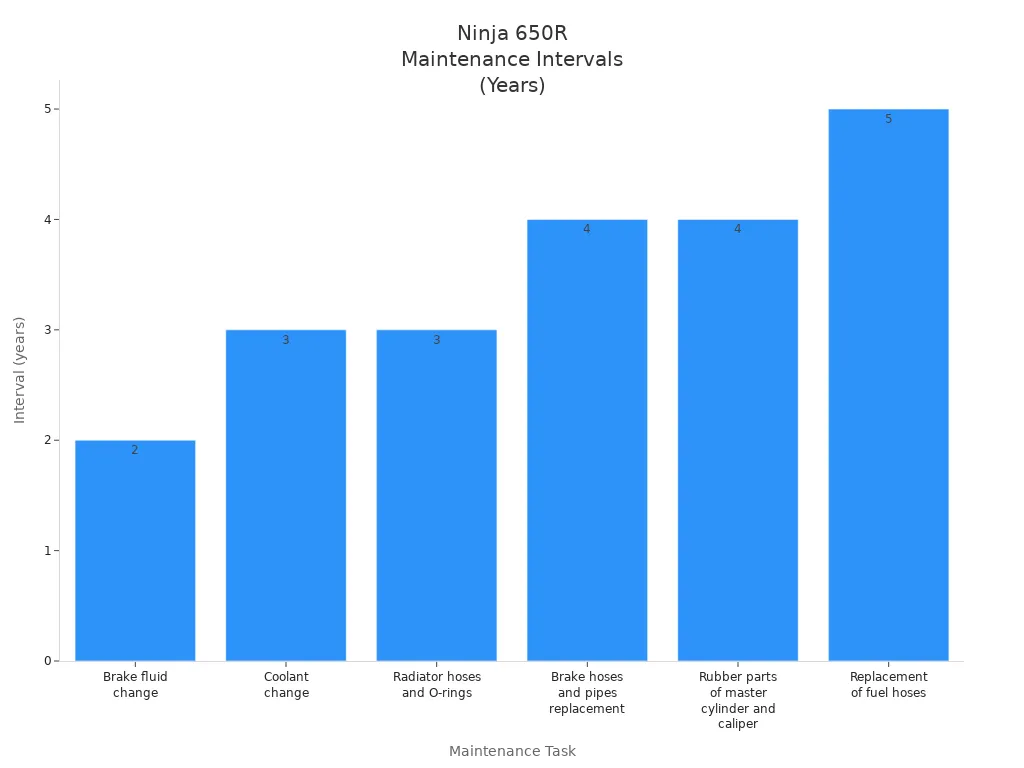
You will not face many common issues if you keep up with these tasks. The motorcycle rewards you with a dependable riding experience year after year.
Tip: Set reminders for oil changes and chain care. Regular checks help you avoid bigger repairs later.
Perceived Weight and Maneuverability
You might think a 650cc motorcycle feels heavy, but the Ninja 650R surprises you. The smart frame design and low center of gravity make it feel much lighter than the numbers suggest. You can push the motorcycle around with ease, and it responds quickly when you turn the handlebars.
When you ride at low speeds, the bike stays balanced and steady. In parking lots or tight spaces, you can move the motorcycle without much effort. On the road, you will notice how easily it leans into corners. This makes your riding experience more fun and less tiring. Many riders say the Ninja 650R feels nimble and confidence-inspiring, whether you ride in the city or on twisty roads.
Long-Term Durability
When you think about keeping a motorcycle for many years, you want to know it will last. The Kawasaki Ninja 650R 2016 has a strong reputation for long-term durability. Many owners report riding their Ninja 650 for over 75,000 miles. Some even reach 100,000 miles with only minor problems. You can expect your bike to last more than 15 years if you take care of it.
Your habits play a big role in how long your Ninja 650R will last. Regular oil changes, chain lubrication, and brake checks help keep the engine and parts in good shape. Following Kawasaki’s service schedule makes a big difference. You should also pay attention to the break-in period during the first 500 to 1,000 miles. This step helps the engine parts fit together well and can add years to your bike’s life.
You may notice some small issues after many miles. Some riders mention fairing vibrations or minor electrical problems, like coil failures. These problems do not stop you from riding, and most are easy to fix. The seat may show wear, but the main parts of the bike stay strong.
Proper storage helps your Ninja 650R last longer. Keeping your bike indoors or under a good cover protects it from rain and moisture. This step prevents rust and keeps the paint looking new.
Many people in the used market think 20,000 miles is high for a Ninja 650R. In reality, a well-cared-for bike can go much farther. Your experience with the Ninja 650R 2016 will likely be positive if you follow simple care steps. This motorcycle gives you a reliable ride for many years.
Kawasaki Ninja 650R 2016 vs. Competing Motorcycles
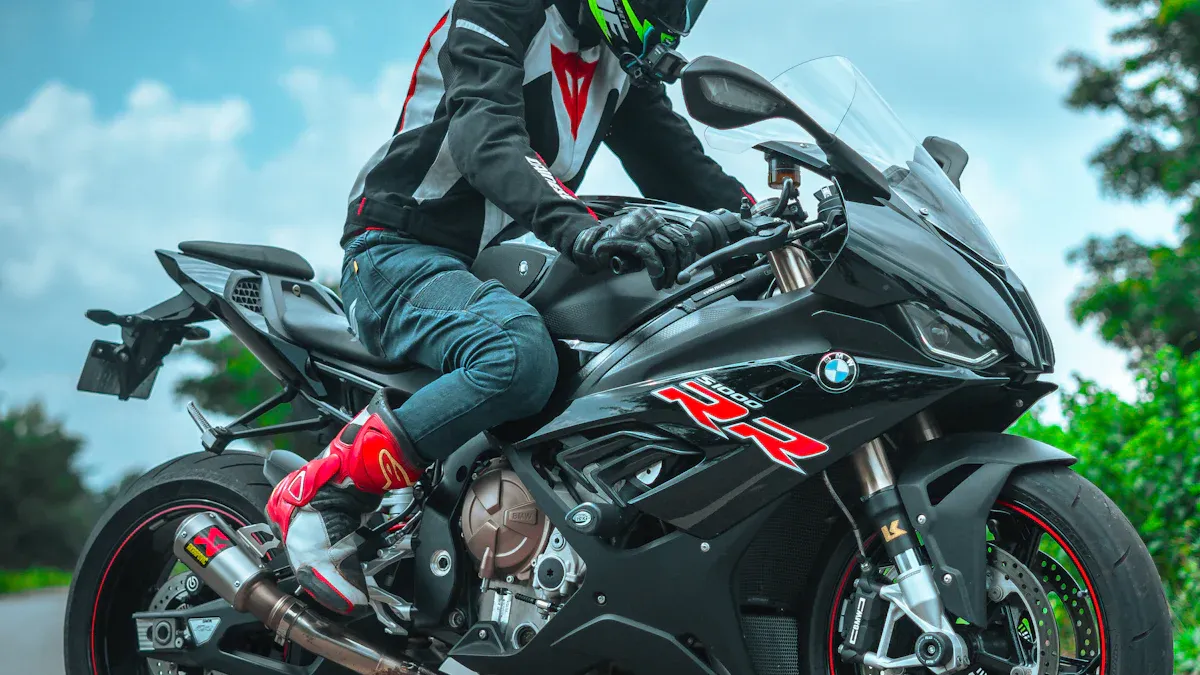
Ninja 650R 2016 vs. Yamaha FZ6R
When you compare the Ninja 650R 2016 to the Yamaha FZ6R, you see two popular choices in the mid-sized sportbike class. Both motorcycles offer strong performance, but each has its own strengths.
- The Ninja uses a 649cc parallel-twin engine with about 64.7 hp and 43 lb-ft of torque. You get strong low- and mid-range power, but you may notice some vibration.
- The Yamaha FZ6R features a 600cc inline-four engine. It produces slightly more horsepower and runs smoother with less vibration.
- The FZ6R feels agile and offers better legroom with an adjustable seat. You may find the Ninja’s riding position more upright, but the legroom feels cramped for taller riders.
- The Ninja 650R includes features like an Assist and Slip clutch and a positive neutral finder. The FZ6R does not offer ABS and looks more dated.
- Price matters. The Ninja costs less and gives you ABS, while the FZ6R is more expensive without ABS.
Tip: If you want a smoother ride and more comfort, the FZ6R stands out. If you want better value and more features for your money, the Ninja 650R is a smart pick.
Ninja 650R 2016 vs. Honda CBR650F
You will notice clear differences between the Ninja 650R and the Honda CBR650F. The Honda costs about 13% more than the Ninja. Many riders trust the Honda’s inline-four engine for its reliability and smooth power. The Ninja’s parallel-twin engine feels more beginner-friendly, but some owners report engine issues over time.
| Feature / Aspect | Ninja 650R 2016 | Honda CBR650F 2016 |
|---|---|---|
| Engine Type | Parallel twin, low vibration | Inline-four, smooth, high-revving |
| Power Output | 72 hp, easy to manage | Power builds at higher rpm |
| Rider Experience | Comfortable, agile | Predictable, sportier feel |
| Price | Lower | About 13% higher |
| Reliability | Some engine issues reported | Very reliable |
| Intended Rider | Beginner to intermediate | Experienced, sporty focus |
The Honda CBR650F feels more like a modern sportbike, with power that comes alive at higher revs. You may prefer the Ninja if you want a motorcycle that is easier to handle and costs less. The Honda suits riders who want a sportier ride and can handle a high-revving engine.
Ninja 650R 2016 vs. Suzuki SV650
When you look at the Suzuki SV650, you find another strong option in the sportbike world. The SV650 uses a V-twin engine, which gives you a unique sound and strong torque at low speeds. You will feel the SV650’s engine pull hard from the start, making it fun for city riding and twisty roads.
The Ninja 650R offers a more upright seating position and a smooth ride. The SV650 feels lighter and more playful in corners. Both motorcycles work well for new riders, but the SV650’s engine character feels different from the Ninja’s parallel-twin. You may find more aftermarket parts for the Ninja, which helps you customize your motorcycle.
Note: If you want a playful ride with a V-twin sound, the SV650 is a great choice. If you want comfort, value, and easy handling, the Ninja 650R stands out in the sportbike class.
You get a motorcycle that balances comfort, value, and sporty looks with the kawasaki ninja 650r 2016. This motorcycle works well for new riders and those who want a reliable daily ride. You enjoy easy handling, strong performance, and low maintenance. If you want a motorcycle that fits city streets or weekend trips, this model gives you a smart choice.
Remember: You can count on this motorcycle for years of dependable riding.
FAQ
Is the Kawasaki Ninja 650R 2016 good for beginners?
You can start on the Ninja 650R 2016. The bike feels light and easy to control. The seat sits low, so you reach the ground easily. Many new riders choose this model for its friendly power and simple handling.
What is the maintenance cost for the Ninja 650R 2016?
You spend less on maintenance compared to high-performance bikes. Oil changes, chain care, and brake checks cost the most. Most riders pay between $200 and $400 per year for basic service.
Does the 2016 Ninja 650R have ABS?
You get ABS as an option on the 2016 Ninja 650R. ABS helps you stop safely, especially on wet roads. If you want extra safety, look for a model with ABS.
How comfortable is the Ninja 650R 2016 for long rides?
You sit upright with relaxed arms and legs. The seat supports your back. Many riders travel over 100 miles in one trip. For extra comfort, you can add a taller windscreen or a softer seat.
What is the fuel range of the Ninja 650R 2016?
You ride over 170 miles on a full tank. The bike averages about 43.5 mpg. The 4.0-gallon tank gives you enough range for daily rides or weekend trips.
See Also
Detailed Analysis of Kawasaki Ninja 650 Fairing Performance
Complete 2025 Review of Kawasaki Ninja H2R Model
Ultimate Guide to Top Aftermarket Fairings for Ninja 400
